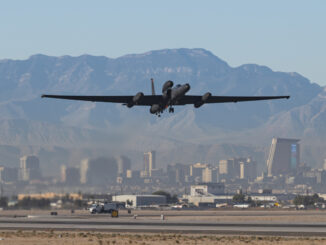 The wreckage of the Lockheed U-2C, a United States spy aeroplane (code name Article 360, 56-6693), which was shot down near Sverdlovsk (today Yekaterinburg) on 1st May 1960. The aircraft is currently on display at Центральный музей Вооружённых Сил Российской Федерации (the Central Armed Forces Museum) in Moscow.
The wreckage of the Lockheed U-2C, a United States spy aeroplane (code name Article 360, 56-6693), which was shot down near Sverdlovsk (today Yekaterinburg) on 1st May 1960. The aircraft is currently on display at Центральный музей Вооружённых Сил Российской Федерации (the Central Armed Forces Museum) in Moscow.
The Lockheed U-2, also nicknamed the Dragon Lady, is a single-engine, ultra-high altitude reconnaissance aeroplane and one of the most well-known aircraft of the Cold War era. However, it was not only the impressive capabilities of the U-2 that earned it such fame. What truly made it a Cold War icon was the so-called U-2 incident, when one of the aircraft was shot down over Soviet territory in 1960.
The U-2 was developed in response to the United States’ need to conduct strategic reconnaissance over the Soviet Union. In the 1950s, all that was available to American intelligence were photographs taken by the Germans during the Second World War and some additional material gathered secretly during official diplomatic visits to the Soviet Union.
The reconnaissance aircraft available at the time were vulnerable to Soviet air defence fighters and missiles, so the development of an entirely new spy aeroplane began in 1953. The new aircraft needed to be capable of crossing Soviet airspace at an altitude of 70,000 feet (21,300 metres) and provide day-and-night, all-weather intelligence — remaining beyond the reach of Soviet radars, fighters, and missiles. This strict altitude requirement was based on the strong belief that Soviet radar systems could not detect targets flying above 65,000 feet (19,500 metres), and knowing that the MiG-17 interceptor had an altitude limit of 45,000 feet (13,500 metres).
On 1st August 1955, the new reconnaissance aircraft made its maiden flight and, within a year, became operational, conducting spy missions over Eastern Europe. Operational use of the U-2s was a joint project of the USAF (providing pilots and training) and the CIA (handling reconnaissance equipment, air bases, and security). The aircraft’s development and initial flights were, of course, highly classified.
Reconnaissance missions over Eastern Europe and the Soviet Union were, unsurprisingly, noticed by Soviet air defences. However, American authorities believed the ultra-high altitude concept was working. Photographs taken by the U-2s showed Soviet fighters attempting to intercept the aircraft, but failing to reach their altitude. It also seemed that Soviet air defences were unable to track the full operational route of the U-2, apparently unaware of flights over Moscow or Leningrad.
During the early years, the U-2s collected general intelligence on Soviet military installations and searched for Bisons — the Myasishchev M-4 heavy bombers. Following the launch of the first artificial Earth satellite, Sputnik 1, on 4th October 1957, the Soviet ballistic missile and space programmes became the primary targets of reconnaissance.
Initial success often leads to complacency, forgetting that the adversary, too, gains experience over time. This was precisely the case with the U-2 programme. On 9th April 1960, an U-2C flew over Soviet territory and four top-secret military targets: an airbase, two missile test sites, and a missile range. That mission was deemed another success — and another flight was scheduled shortly afterwards.
The next flight, codenamed ´Grand Slam´, was to be yet another spectacular mission over the Soviet territory. The U-2C, piloted by Captain Francis Gary Powers, took off from Peshawar Air Base in Pakistan on 1st May 1960, with the aim of flying over the Soviet Union and landing in Bodø, Norway.
However, this flight had been anticipated by Soviet air defences, which had also tracked the entire previous mission. Despite several failed attempts to intercept Powers’ U-2 initially, the reconnaissance flight was ultimately brought down near Kosulino, Sverdlovsk Oblast.
It was the recently introduced S-75 Dvina surface-to-air missile system (NATO reporting name: SA-2 Guideline), and one of its missiles launched by a battery commanded by Major Mikhail Voronov, that struck Powers’ aircraft. Powers managed to eject, parachuted safely, and was captured shortly afterwards.
The U-2 incident triggered a diplomatic crisis between the United States and the Soviet Union, particularly as Powers was shot down just days before the planned Four Power Paris Summit and President Eisenhower’s scheduled visit to the USSR.
Powers was sentenced to ten years — the first three in prison, followed by seven years in a labour camp — but in February 1962 he was exchanged for Rudolf Abel, the Soviet spy captured by the FBI in 1957. The exchange famously took place on the Glienicke Bridge in Berlin, nicknamed the Bridge of Spies.
As a result of the U-2 incident, US reconnaissance activity was temporarily suspended while new procedures and policies were developed. The U-2s soon returned to active duty, but the era of deep-penetration flights over the Soviet Union had ended — they would never again violate Soviet airspace.
Francis Gary Powers resumed flying in 1962, working as a test pilot for Lockheed. He later became a helicopter traffic reporter for KNBC News Channel 4. He died on 1st August 1977, when his Bell 206 Ranger helicopter crashed in California.


